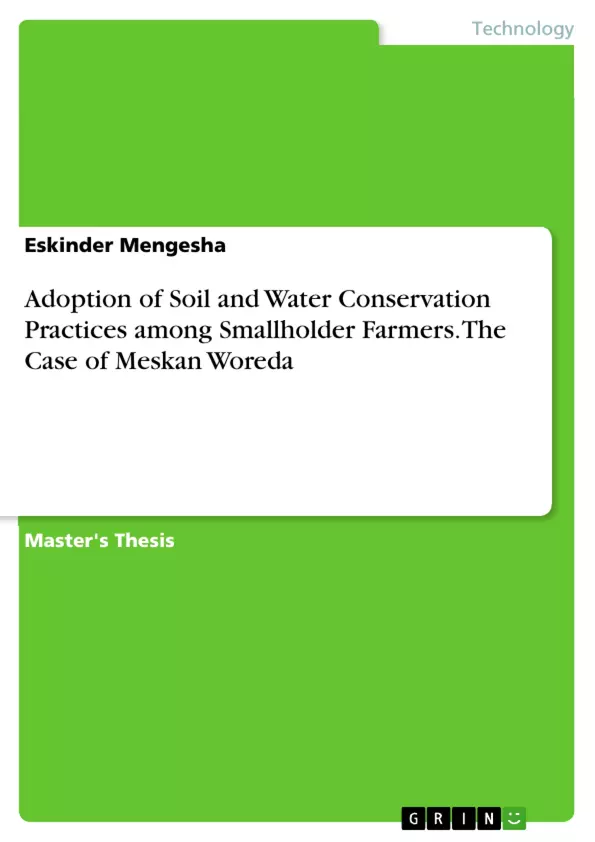The objectives of the research were (1) to assess level of use of soil conservation measures by small holder farmers, (2) to identify the factors that influence small holder farmers to participate in soil conservation activities and (3) to identify most commonly used indigenous and improved soil conservation techniques.
Multistage sampling procedure was employed for the realization of the research objectives. In the first stage the research area was selected purposively for geographic and economic advantage convenience. In the second stage three sample kebeles were selected by stratifying based on agro ecology then purposively in consideration of their accesability. In the third stage a total of 150 sample respondents were selected by simple random sampling based on PPS. Structured interview schedule was developed, pre-tested and used for collecting the essential data for the study from the sampled households. Focus group discussions and key informant interviews were also conducted to generate qualitative. Descriptive statistics was used to describe the nature of data by indicating the significance of the relationship between dependent variable and independent variable. Binary logit model was used to determine the relative influence of independent variables on the dependent variable.
The result of descriptive statistics revealed that out of the total sample respondents 63.3% were adopters and 36.7% of them were non-adopters. It also indicated that in the study area, livestock holding, family size, education, age, participation in training of soil and water conservation, farm income, social position, Number of economically active labor, land size, frequency of extension contact, perception of ownership of land and slope were found to be significantly affecting adoption of soil and water conservation technology by farmers.
The model result revealed that education of head of household, farm income of the household, frequency of extension contact, number of economically active labour in the household and perception on ownership of land were found positively and significantly affect adoption of soil and water conservation structures. While sex of head of household and age of head of household were negatively and significantly related with adoption of soil and water conservation technology by farmers. Thus, consideration of those variables would help to improve adoption of physical soil and water conservation technology among farm households.
Inhaltsverzeichnis (Table of Contents)
- LIST OF ABBREVIATIONS
- BIOGRAPHY
- ACKNOWLEDGMENTS
- CHAPTER ONE: INTRODUCTION
- 1.1 Background of the Study
- 1.2 Statement of the Problem
- 1.3 Objectives of the Study
- 1.3.1 General Objective
- 1.3.2 Specific Objectives
- 1.4 Research Questions
- 1.5 Significance of the Study
- 1.6 Scope and Limitation of the Study
- 1.7 Organization of the Study
- CHAPTER TWO: LITERATURE REVIEW
- 2.1 Concept of Soil and Water Conservation
- 2.1.1 Definition of Soil and Water Conservation
- 2.1.2 Importance of Soil and Water Conservation
- 2.1.3 Major Soil and Water Conservation Practices
- 2.2 Factors Influencing Adoption of Soil and Water Conservation Practices
- 2.2.1 Socio-economic Factors
- 2.2.2 Institutional Factors
- 2.2.3 Bio-physical Factors
- 2.3 Adoption of Soil and Water Conservation Practices in Ethiopia
- 2.4 Theoretical Framework
- CHAPTER THREE: MATERIALS AND METHODS
- 3.1 Study Area Description
- 3.1.1 Location and Geography
- 3.1.2 Socio-economic and Cultural Features
- 3.1.3 Agro-ecology
- 3.2 Population and Sampling Techniques
- 3.2.1 Target Population
- 3.2.2 Sampling Techniques
- 3.2.3 Sample Size Determination
- 3.3 Data Collection Methods and Tools
- 3.3.1 Data Collection Methods
- 3.3.2 Data Collection Tools
- 3.4 Data Analysis Techniques
- CHAPTER FOUR: RESULTS AND DISCUSSIONS
- 4.1 Socio-economic Characteristics of Smallholder Farmers
- 4.2 Factors Influencing Adoption of Soil and Water Conservation Practices
- 4.3 Practices of Soil and Water Conservation Adopted
- 4.4 Constraints Faced in Adoption of Soil and Water Conservation Practices
- 4.5 Determinants of Adoption of Soil and Water Conservation Practices
- CHAPTER FIVE: SUMMARY, CONCLUSIONS AND RECOMMENDATIONS
- 5.1 Summary
- 5.2 Conclusions
- 5.3 Recommendations
Zielsetzung und Themenschwerpunkte (Objectives and Key Themes)
The thesis aims to investigate the adoption of soil and water conservation practices among smallholder farmers in the Meskan woreda of the Guraghe Zone in the Southern Nations, Nationalities and Peoples Region (SNNPR) of Ethiopia. The research explores the socio-economic, institutional, and bio-physical factors influencing the adoption of these practices. It analyzes the specific practices adopted by farmers and the constraints they face in implementing them.
- Adoption of soil and water conservation practices by smallholder farmers
- Factors influencing adoption of soil and water conservation practices
- Constraints faced in adopting soil and water conservation practices
- Determinants of adoption of soil and water conservation practices
- Impact of soil and water conservation practices on agricultural production
Zusammenfassung der Kapitel (Chapter Summaries)
Chapter One provides an introduction to the research, outlining the background, statement of the problem, objectives, research questions, significance, scope, and limitations of the study. It also presents the organization of the thesis. Chapter Two reviews relevant literature on the concept of soil and water conservation, factors influencing adoption, adoption in Ethiopia, and the theoretical framework. Chapter Three details the materials and methods used in the research, including a description of the study area, population and sampling techniques, data collection methods and tools, and data analysis techniques. Chapter Four presents the findings of the research, focusing on the socio-economic characteristics of smallholder farmers, factors influencing adoption, practices adopted, constraints faced, and determinants of adoption. It discusses the results and their implications. Chapter Five summarizes the key findings, draws conclusions, and provides recommendations for further research and policy development.
Schlüsselwörter (Keywords)
The research focuses on the adoption of soil and water conservation practices, smallholder farmers, Ethiopia, Meskan woreda, Guraghe Zone, SNNPR, socio-economic factors, institutional factors, bio-physical factors, determinants of adoption, constraints, agricultural production, sustainable land management.
- Citation du texte
- Eskinder Mengesha (Auteur), 2018, Adoption of Soil and Water Conservation Practices among Smallholder Farmers. The Case of Meskan Woreda, Munich, GRIN Verlag, https://www.grin.com/document/1266518



